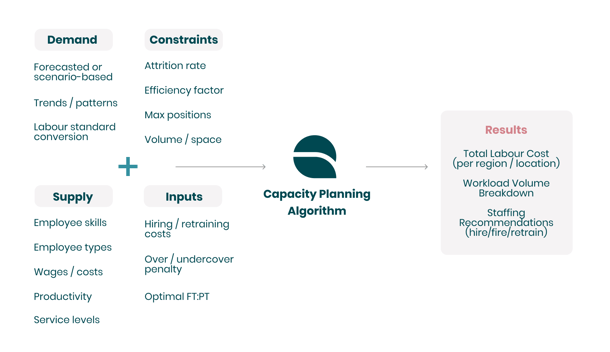In retail, effective labor capacity budgeting isn’t just important—it’s a game-changer. This process helps retailers figure out how many staff they need and what it’ll cost based on expected workloads. Whether it’s for the year, the quarter, or the week, getting these numbers right keeps operations smooth and costs under control. Sure, calculating labor costs might seem simple—hours worked times employee rates—but there’s a lot more to it. Think about the impact of opening new stores, investing in tech that changes how work gets done, or even adapting to wage hikes. These aren’t just number-crunching tasks—they’re strategic moves that need serious thought.
That’s where advanced strategic planning tech comes in. It doesn’t just simplify the complexity; it ensures you’ve got the right staffing mix to tackle whatever the future throws at you. Ready to get ahead?
Let’s dive into how this tech can set you up for success.
Step 1: What is Labor Capacity Budgeting?
Retailers use labor capacity budgeting practices to determine their yearly, quarterly, or weekly labor costs based on an expected workload. Annual or periodic budgets typically include historical averages of sales, a growth factor, and some forecast of labor. It’s easy for organizations to calculate the cost of their labor by simply calculating what hours were worked multiplied by the cost of each worker. But a common misconception is the ease of determining the hours that should be worked while also strategically staffing far into the future. This is a challenge for retailers that want to consider multiple organizational changes that may impact the structure of their current staff and ultimately their overall labor budget. Common questions include: What if I open a new store? What if I invest in new technology that changes my labor standards? What if the minimum wage increases and I want to save on increasing staffing costs? In order to calculate what my staffing hours should look like and the associated cost in all potential future scenarios, retailers need timely insight into what the optimal staffing mix should be, and what recruitment efforts may be needed to accommodate for these realistic changes in the business.
Handling all projected future scenarios may sound like a headache, however, strategic planning technology can solve it all, in a matter of seconds. Simplifying the process of understanding and planning staffing levels strategically is important for organizations to operate efficiently. Helping retailers retain the appropriate recruitment efforts and staffing levels as an accurate and necessary input into their labor budget is easily solved with optimization, or what’s known as, strategic planning algorithms. With this type of technology, I (as a retailer) can plan for the future knowing the recommended staffing levels are determined with my costs and organization in mind.

Step 2: Why use strategic planning technology?
So how does one strategically plan to get the right mix of employees to meet changing demand throughout the year? With strategic planning algorithms, reducing the complexity of workforce planning can be solved in a matter of seconds.
Technology can reduce the inefficiency of manual calculations through easy iterations of changeable inputs, allowing the creation of “what-if” scenarios. With the consideration of multiple user-based factors such as optimal ratios, costs of recruitment efforts, and penalties for over or understaffing relative to the demand, dynamic and required staffing levels are calculated at each week of the budgeted time frame.
Having accurate insight into your future labor pool allows you to build your ideal workforce; one that is optimized to reduce excess labor expenses, reduce lost sales opportunities with fluctuating staffing levels, and improve productivity. Beyond building the ideal workforce, the algorithms provide a more realistic and timely input into the labor budgeting process as a whole.
Step 3: How does the Strategic algorithm actually work?
The strategic algorithm’s goal is to minimize the gap between the required headcount and current supply for each budgeted time period. The algorithm takes projected demand hours, aligns them with the current supply hours (including attrition rate), and optimizes the alignment of staffing levels with recommendations on when to hire, reallocate, or re-train employees in order to cover the demand. Recommendations are provided at the weekly level, ensuring each level of employees is able to appropriately cover the forecasted peaks and valleys in the upcoming demand.

The algorithm also takes into consideration a combination of business constraints, including the cost of hiring or re-training specific employee types, the desired/optimal full time to part-time ratio, the efficiency rate of each employee type, as well as weighted penalties of over/under covering the demand curve (see graph above). For example, if there is a seasonal demand spike, the algorithm will recommend what type of staff to hire or re-train and when to hire them – based on efficiency factors, targeted service level, and costs to cover the curve. The end goal is to maximize coverage while minimizing added staffing costs or potentially lost revenue.
Strategically planning future staffing levels not only helps save added labor costs and increase service levels but also helps align the labor budgeting process. Increased transparency of staffing levels and their respective costs to the organization allow for a holistic labor budget – one that accounts for every week’s staffing needs backed by optimization.
Step 4: How can the strategic planning technology benefit you?
Are you looking to streamline your workforce? Do you need increased insight into your yearly, quarterly, or monthly staffing requirements? Consider using optimization to strategically plan your next staffing move, whether that be using the strategic algorithm to solve your yearly projected staffing outlook, or running optimized rosters into the strategic algorithm to generate your ideal staff mix. Our workforce optimization algorithms are designed to align all the complexities when it comes to staffing.
![<p data-pm-slice="1 1 []">Read more</p>](https://hubspot-no-cache-eu1-prod.s3.amazonaws.com/cta/default/1545537/interactive-303378350296.png)

